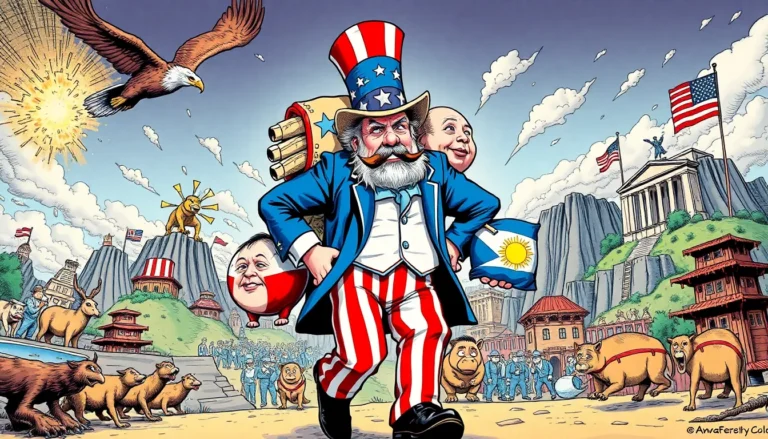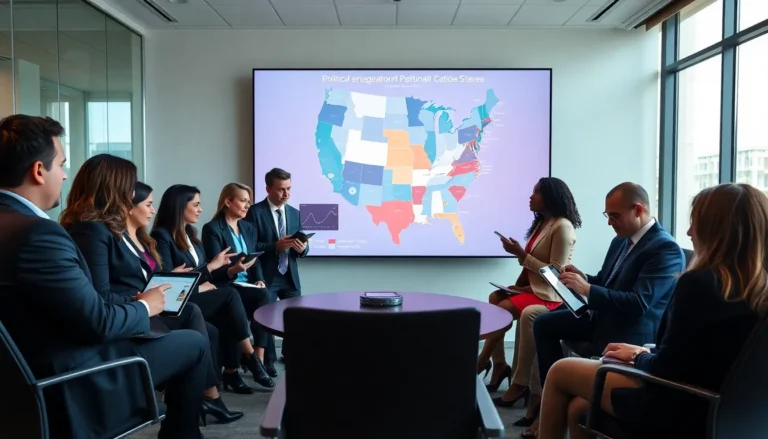Political change is like that friend at the party who decides to switch the music from ballads to thrash metal, unexpected, loud, and often a little chaotic. But understanding political change isn’t as jarring if you investigate into its nuances. In a world where elections can turn tides overnight and social movements can alter the course of history, knowing the dynamics of political change can provide clarity. From revolutions that topple regimes to subtle shifts in policy, the spectrum of political change affects us all. So, what really fuels this wild dance of governance? Let’s unravel the layers of political transformation and see how they influence our lives.
Table of Contents
ToggleDefining Political Change

Political change refers to alterations in the structures, policies, or processes of government and society. It can be as dramatic as a coup d’état or as subtle as a shift in public opinion that encourages lawmakers to revisit existing regulations. Understanding this concept necessitates an appreciation for its complex nature. It encompasses not only tangible changes, like new legislation or leadership, but also shifts in ideology, governance, and public engagement. Essentially, political change isn’t merely about who holds the power, but rather how that power is exercised and perceived by society.
Types of Political Change
Political change can manifest in various forms, each with its unique characteristics and implications.
Revolutionary Change
Revolutionary change involves a complete overhaul of the existing political system. Frequently accompanied by civil unrest, revolutions often seek to dismantle oppressive structures and establish new governance paradigms.
Evolutionary Change
In contrast, evolutionary change happens gradually. This type often results from reforms where institutions adapt incrementally to shifting societal needs without a complete disruption. Such changes may involve legal amendments or policy reforms that respond to public demands.
Regime Change
Regime change refers to the substitution of one governing authority for another. This can occur through elections or unrest, often influencing international relations and domestic stability significantly.
Policy Change
Policy change may be the most common manifestation, involving alterations to laws and regulations impacting society at various levels.
Collectively, these types of changes shape not just governance but also the daily lives of citizens.
Causes of Political Change
Various forces spur political change, and these catalysts can overlap. Understanding them provides insight into the motivations behind shifts in governance.
Economic Factors
Poor economic performance often ignites political change. When citizens struggle to make ends meet, they may call for political reforms, fueling discontent that can lead to protests or, in extreme cases, revolutions.
Social Factors
Social movements can catalyze change, uniting individuals around common goals like civil rights or environmental protection. They often challenge the status quo and demand accountability from political leaders.
Technological Advances
The rise of digital media and technology has transformed political communication. Information spreads rapidly, oftentimes igniting discussions that can culminate in political movements, as seen in events like the Arab Spring.
Global Events
International events, including wars, treaties, and economic crises, can trigger political change. The interconnectedness of countries means that actions taken elsewhere can reverberate across borders, prompting domestic shifts.
The Role of Social Movements in Political Change
Social movements play a crucial role in instigating political change. They emerge when a group of individuals mobilizes around a shared concern, aiming to influence public opinion and policy.
Mobilization Strategies
Typically, social movements employ various strategies to achieve their goals, ranging from protests and marches to advocacy campaigns. Their effectiveness often hinges on their ability to garner widespread support and media attention.
Historical Impact
Historically, movements like the Civil Rights Movement in the U.S. exemplify how grassroots activism can lead to significant legal and social changes. Leaders like Martin Luther King Jr. not only galvanized support but also reached broader audiences through compelling narratives of justice and equality.
Contemporary Movements
In recent years, movements such as Black Lives Matter and climate strikes led by youth activists demonstrate the ongoing power of collective action. These movements leverage social media to spread their messages, illustrating the modern intersection of technology and activism.
Case Studies of Political Change
Examining specific case studies can illustrate the nuances of political change.
The Fall of the Berlin Wall
The Berlin Wall’s fall in 1989 marked an iconic moment in political change. It not only signified the end of the Cold War but also initiated the reunification of Germany and the broader integration of Eastern and Western Europe. The event underscored the power of collective public sentiment and nonviolent protest.
Arab Spring
The Arab Spring serves as another poignant example. Sparked by protests against oppressive regimes, this series of uprisings highlighted the interconnectedness of modern political movements. Even though varied outcomes, it showcased the potential for rapid political change fueled by social media and grassroots activism.
Recent US Elections
The changes in leadership during recent U.S. elections underscore how swiftly public sentiment can shift political landscapes. Grassroot campaigns, digital engagement, and voter mobilization have made significant impacts, leading to a more politically active society.
Challenges and Barriers to Political Change
Even though the potential for political change, several barriers often inhibit progress.
Institutional Resistance
Established institutions frequently resist changes to maintain the status quo. This inertia can stem from a fear of losing power or disrupting existing societal structures.
Public Apathy
A lack of public engagement can stifle political change. When citizens feel disconnected or disillusioned with the political process, their apathy can undermine movements aimed at reform.
Misinformation
In the digital age, misinformation spreads rapidly, often skewing public perceptions and confusing issues. This can complicate efforts to mobilize support around key reforms, as political factions exploit division rather than unity.
The Future of Political Change
Looking ahead, the future of political change remains dynamic and unpredictable.
Technological Influence
As technology continues to evolve, its role in facilitating change will only grow. Enhanced communication capabilities can allow movements to organize and spread quickly, yet they also raise concerns about privacy and information manipulation.
Inclusivity in Movements
Future political change may become increasingly inclusive as diverse voices rise to prominence. This shift is essential to address long-standing inequalities and ensure equitable representation in governance.
Global Collaboration
Collaboration across borders may foster political changes that transcend national interests. As global challenges like climate change continue to demand collective action, international cooperation is likely to play a significant role.





